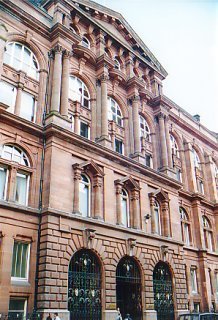University of Strathclyde
University of Strathclyde is a public research university located in Glasgow, Scotland. Founded in 1796 as the Andersonian Institute, it is Glasgow's second-oldest university, having received its royal charter in 1964 as the first technological university in the United Kingdom. Taking its name from the historic Kingdom of Strathclyde, the University of Strathclyde is known for its strong emphasis on innovation and entrepreneurial spirit, aligning with its motto, "The Place of Useful Learning."
History[edit | edit source]
The origins of the University of Strathclyde can be traced back to 1796 when Professor John Anderson bequeathed his estate for the foundation of an institution dedicated to the "Good of Mankind" and the "Improvement of Science." This led to the establishment of the Andersonian Institute, which evolved over the years through various incarnations, including a technical college, before becoming the University of Strathclyde. The transformation into a university in 1964 marked a significant milestone, allowing it to award degrees and expand its research capabilities.
Campus[edit | edit source]
The University of Strathclyde's main campus is situated in the heart of Glasgow, near the River Clyde. It is known for its blend of historic buildings and modern architecture, providing a dynamic environment for its students and staff. The university has made significant investments in its facilities, including the Technology and Innovation Centre, which fosters collaboration between researchers, industry, and government.
Academic Profile[edit | edit source]
The University of Strathclyde is organized into four main faculties: the Faculty of Engineering, the Faculty of Science, the Strathclyde Business School, and the Faculty of Humanities and Social Sciences. Each faculty is home to various departments offering a wide range of undergraduate, postgraduate, and research degrees.
Research[edit | edit source]
Strathclyde is renowned for its research impact, particularly in areas such as pharmacy and biomedical engineering, energy, and public policy. The university's approach to research is interdisciplinary, encouraging collaboration across traditional subject boundaries to address complex global challenges.
Student Life[edit | edit source]
Student life at the University of Strathclyde is vibrant and diverse, with numerous clubs, societies, and sports teams. The Students' Union plays a crucial role in the university community, providing support, entertainment, and opportunities for students to engage in university life beyond academics.
Notable Alumni and Faculty[edit | edit source]
The University of Strathclyde has produced a number of notable alumni and faculty members, including John Logie Baird, the inventor of the television; Dame Elish Angiolini, former Lord Advocate of Scotland; and Jim McColl, one of Scotland's most successful entrepreneurs.
Conclusion[edit | edit source]
The University of Strathclyde continues to uphold its founding principle of being "The Place of Useful Learning" by fostering an environment where innovation, research, and entrepreneurship thrive. Its commitment to making a positive impact on society and the economy is evident through its contributions to science, technology, and industry.
Search WikiMD
Ad.Tired of being Overweight? Try W8MD's physician weight loss program.
Semaglutide (Ozempic / Wegovy and Tirzepatide (Mounjaro / Zepbound) available.
Advertise on WikiMD
|
WikiMD's Wellness Encyclopedia |
| Let Food Be Thy Medicine Medicine Thy Food - Hippocrates |
Translate this page: - East Asian
中文,
日本,
한국어,
South Asian
हिन्दी,
தமிழ்,
తెలుగు,
Urdu,
ಕನ್ನಡ,
Southeast Asian
Indonesian,
Vietnamese,
Thai,
မြန်မာဘာသာ,
বাংলা
European
español,
Deutsch,
français,
Greek,
português do Brasil,
polski,
română,
русский,
Nederlands,
norsk,
svenska,
suomi,
Italian
Middle Eastern & African
عربى,
Turkish,
Persian,
Hebrew,
Afrikaans,
isiZulu,
Kiswahili,
Other
Bulgarian,
Hungarian,
Czech,
Swedish,
മലയാളം,
मराठी,
ਪੰਜਾਬੀ,
ગુજરાતી,
Portuguese,
Ukrainian
Medical Disclaimer: WikiMD is not a substitute for professional medical advice. The information on WikiMD is provided as an information resource only, may be incorrect, outdated or misleading, and is not to be used or relied on for any diagnostic or treatment purposes. Please consult your health care provider before making any healthcare decisions or for guidance about a specific medical condition. WikiMD expressly disclaims responsibility, and shall have no liability, for any damages, loss, injury, or liability whatsoever suffered as a result of your reliance on the information contained in this site. By visiting this site you agree to the foregoing terms and conditions, which may from time to time be changed or supplemented by WikiMD. If you do not agree to the foregoing terms and conditions, you should not enter or use this site. See full disclaimer.
Credits:Most images are courtesy of Wikimedia commons, and templates, categories Wikipedia, licensed under CC BY SA or similar.
Contributors: Prab R. Tumpati, MD






